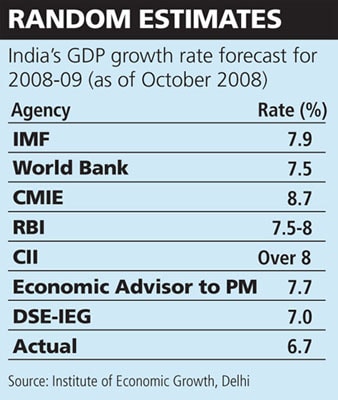
GDP: And The Right Number Is...
One set of data. Different GDP predictions for India
The Indian economy seems to be back on track despite a poor monsoon. The Reserve Bank of India cranked up the economic growth forecast for the current financial year from 6 percent to 7.5 percent.
The Prime Minister, a distinguished economist himself has pegged it at 7 percent and his finance minister estimates it at 7.75 percent.
It’s a mystery how, presumably, the same set of data would allow for such variety for forecasts. Some of the more frequently distributed forecasts of economic growth in India seem to follow the trend more than predict it.
Take the GDP forecasts by the Centre for Monitoring Indian Economy (CMIE). After the collapse of Lehman Brothers in September 2008, every successive month brought bad news for the world economy. The CMIE forecasts reflected that: GDP growth rate got revised from 9.4 percent in September 2008 to 8.2 percent in November and 6.5 percent in April 2009.
The Indian economy actually grew by 6.7 percent that year (08-09) and to be fair to CMIE, most other forecasters also got it wrong (see table). One notable exception is the 7 percent estimate by the Delhi School of Economics and Institute of Economic Growth (DSE-IEG) based on the India-LINK macro-econometric model.
“People laughed at us when we predicted a 7 percent growth as early as August 2008 while most other s were around 9 percent,” says N.R. Bhanumurthy, co-designer, DSE-IEG model.
(This story appears in the 05 March, 2010 issue of Forbes India. To visit our Archives, click here.)















